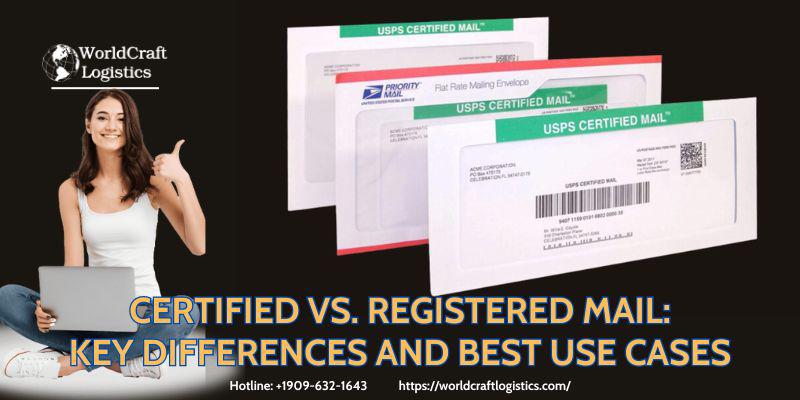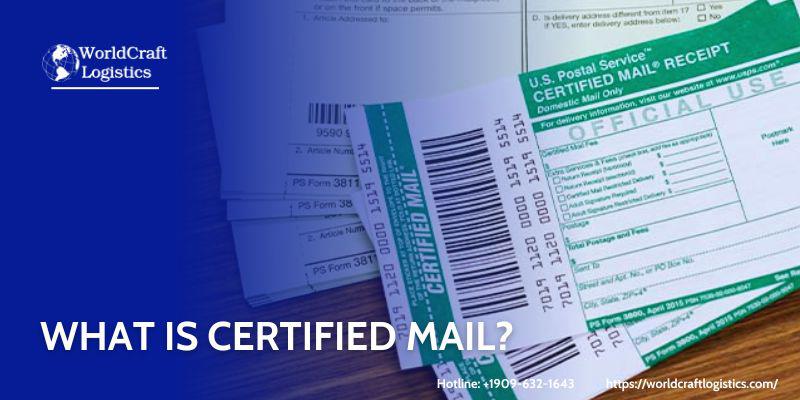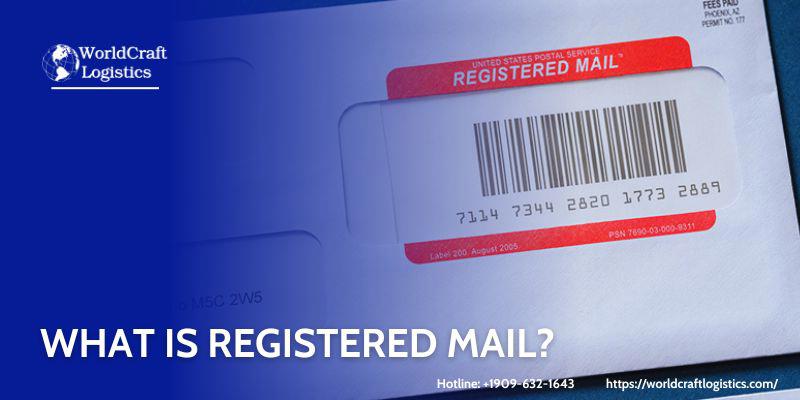
Starting June 1st, 2023 Our warehouse fee will be $0.65/cubic foot per month
In effort to lower the warehouse storage fee during inflation, we have went narrow aisle racking.This construction took us four months but the project is finally completed. With narrow aisle racking, we are able to drop storage by 24%.We as partners will go through this inflation together.
09/16/2024
When it comes to sending important documents or packages through the mail, ensuring their safe and timely delivery is paramount. Among the various mailing options offered by postal services, Certified Mail and Registered Mail stand out as two of the most secure methods. However, they cater to different needs and come with distinct features. This article delves into the differences between Certified and Registered Mail, WorldcraftLogistics.com helps you choose the best solution to suit your specific requirements.

While both Certified and Registered Mail offer tracking and delivery confirmation, there are significant differences in their features and intended use. Understanding these differences will help you choose the right service for your needs, here is a detailed comparison table:
Certified Mail | Registered Mail | |
Level of Security | Provides a basic level of security with tracking and delivery confirmation. It is suitable for items that require proof of mailing and delivery but do not need the highest level of security. | Offers the highest level of security, with enhanced tracking, restricted access, and insurance coverage. It is ideal for valuable or sensitive items that require maximum protection. |
Cost | Generally more affordable than Registered Mail, making it a cost-effective option for sending documents and packages that need tracking and delivery confirmation. | More expensive due to the additional security measures, insurance coverage, and handling protocols. The higher cost is justified for items of significant value. |
Tracking Capabilities | More expensive due to the additional security measures, insurance coverage, and handling protocols. The higher cost is justified for items of significant value. | Provides more detailed tracking, with each step of the item's journey logged. This includes the date and time the item is received, processed, and delivered. |
Insurance Coverage | Does not include insurance, although it can be purchased separately if needed. | Includes insurance coverage, with the option to increase the coverage based on the item's value. This feature provides financial protection in case of loss or damage. |
Intended Use | Best suited for sending documents that require proof of mailing and delivery but do not need the highest level of security. | Ideal for sending valuable or sensitive items that require enhanced security, tracking, and insurance coverage. |
Certified Mail is a service provided by postal services that offers proof of mailing and delivery for important documents or packages. It is often used for sending legal documents, tax forms, and other sensitive items where confirmation of receipt is required. Certified Mail includes tracking capabilities, allowing the sender to monitor the package's journey and receive a confirmation once it has been delivered.

Proof of Mailing: When you send a letter or package via Certified Mail, you receive a receipt that serves as proof of mailing. This receipt includes a unique tracking number that allows you to track the item online.
Tracking: Certified Mail offers end-to-end tracking, providing updates on the package's status as it moves through the postal system. This feature ensures that both the sender and recipient can monitor the progress of the delivery.
Delivery Confirmation: Upon delivery, a record is made, and the sender can receive a confirmation, either online or via a return receipt. This confirmation acts as proof that the item has reached its intended recipient.
Return Receipt Option: For an additional fee, senders can request a return receipt, which the recipient signs upon delivery. This receipt is then mailed back to the sender as physical proof of delivery.
Legal Documents: Lawyers and legal firms often use Certified Mail to send court documents, contracts, and other legal papers that require confirmation of delivery.
Tax Returns: Individuals and businesses frequently use Certified Mail to send tax returns to ensure they have proof of submission.
Business Communications: Certified Mail is commonly used by businesses to send important communications, such as notices of termination, debt collection letters, and other sensitive information.
Registered Mail is a premium postal service that offers the highest level of security and accountability for valuable items. It is often used for sending cash, high-value items, or important documents that require maximum protection and traceability. Registered Mail provides detailed tracking, insurance coverage, and secure handling from the moment the item is mailed until it reaches its destination.

Enhanced Security: Registered Mail items are handled separately from regular mail and are placed in a secure facility during transit. Each item is carefully tracked and logged at every stage of its journey.
Insurance Coverage: Registered Mail includes insurance coverage, which can be increased depending on the value of the item being sent. This coverage provides peace of mind in case of loss or damage during transit.
Tracking and Monitoring: Registered Mail offers detailed tracking, with each step of the item's journey recorded. This level of monitoring ensures that the item is accounted for at every stage, from acceptance to delivery.
Restricted Access: Only authorized personnel have access to Registered Mail items during transit. This restriction minimizes the risk of theft or tampering.
Delivery Confirmation: Similar to Certified Mail, Registered Mail also provides delivery confirmation. However, the process is more stringent, with additional security measures in place to ensure that the item is delivered safely.
Valuable Items: Registered Mail is often used to send cash, jewelry, precious metals, and other high-value items that require maximum security.
Important Documents: Businesses and individuals use Registered Mail to send documents that are irreplaceable or extremely valuable, such as wills, deeds, and certificates.
International Shipments: When sending valuable items overseas, Registered Mail is the preferred choice due to its enhanced security and international tracking capabilities.

When deciding between Certified vs Registered Mail, consider the nature of the item you are sending, its value, and the level of security required. If you need proof of mailing and delivery for a document or package that is not particularly valuable, Certified Mail is a cost-effective and reliable option. However, if you are sending something of significant value or importance, Registered Mail provides the security, insurance, and detailed tracking necessary to ensure its safe delivery.
Example Scenarios:
Sending a Legal Document: If you are sending a legal document that requires proof of delivery but is not highly valuable, Certified Mail is sufficient. It provides tracking and delivery confirmation at a reasonable cost.
Shipping a Valuable Item: When shipping a valuable item like jewelry or a rare coin, Registered Mail is the better choice. The enhanced security and insurance coverage ensure that the item is protected throughout its journey.
International Shipments: For international shipments of valuable items, Registered Mail offers the best protection, with secure handling and comprehensive tracking across borders.
Articles related to knowledge, comparison of other terms may interest you. Hope that Worldcraft Logistics' articles meet your needs
👉 Shipping Dates & Delivery Dates: Differences & Importance Explained
👉 Difference Between Billing and Mailing Address
👉 Single Entry Bond and Continuous Bond: Meaning, the Differences
Certified Mail and Registered Mail are both valuable services offered by postal systems worldwide, each catering to different needs. Certified Mail is ideal for sending documents and packages that require tracking and delivery confirmation, while Registered Mail is the go-to option for high-value or sensitive items that require maximum security. By understanding the differences between these two services, you can make informed decisions that ensure your important items are delivered safely and securely.
Remember, the choice between Certified and Registered Mail depends on the value of the item, the level of security required, and the importance of tracking and delivery confirmation. Choose wisely to ensure your peace of mind.
SEO
Digital Marketing/SEO Specialist
Simon Mang is an SEO and Digital Marketing expert at Wordcraft Logistics. With many years of experience in the field of digital marketing, he has shaped and built strategies to effectively promote Wordcraft Logistics' online presence. With a deep understanding of the logistics industry, I have shared more than 500 specialized articles on many different topics.

Education
01/05/2025

Education
02/18/2025

Education
01/01/2024

Education
08/28/2024

Education
11/13/2023